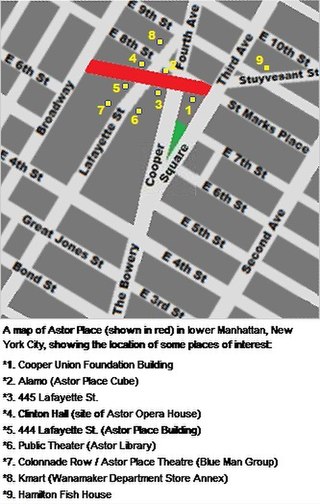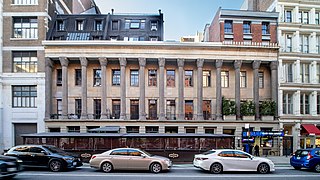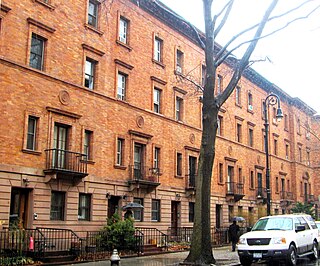Trinity Church is a historic parish in the Episcopal Diocese of New York, whose church is located at 89 Broadway opposite Wall Street, in the Financial District of Lower Manhattan in New York City. Known for its centuries of history, prominent location, distinguished architecture and bountiful endowment, Trinity's congregation is said to be "high church", its activities based on the traditions of the Episcopal Church and the worldwide Anglican Communion in missionary outreach, and fellowship. In addition to its main church, Trinity parish maintains two chapels: St. Paul's Chapel, and the Chapel of St. Cornelius the Centurion on Governors Island. The Church of the Intercession, the Trinity Chapel Complex and many other of Manhattan's Anglican congregations were once part of Trinity parish. Columbia University was founded on the church's grounds as King's College in 1754.

NoHo, short for North of Houston Street, is a primarily residential neighborhood in Lower Manhattan in the New York City borough of Manhattan. It is bounded by Mercer Street to the west and the Bowery to the east, and from East 9th Street in the north to East Houston Street in the south.

The Alexander Hamilton U.S. Custom House is a government building, museum, and former custom house at 1 Bowling Green, near the southern end of Manhattan in New York City, New York, United States. Designed by Cass Gilbert in the Beaux-Arts style, it was erected from 1902 to 1907 by the government of the United States as a headquarters for the Port of New York's duty collection operations. The building contains the George Gustav Heye Center museum, the United States Bankruptcy Court for the Southern District of New York, and the New York regional offices of the National Archives. The facade and part of the interior are New York City designated landmarks, and the building is listed on both the New York State Register of Historic Places and the National Register of Historic Places (NRHP) as a National Historic Landmark. It is also a contributing property to the Wall Street Historic District, listed on the NRHP.

Astor Place is a one-block street in NoHo/East Village, in the lower part of the New York City borough of Manhattan. It runs from Broadway in the west to Lafayette Street. The street encompasses two plazas at the intersection with Cooper Square, Lafayette Street, Fourth Avenue, and Eighth Street – Alamo Plaza and Astor Place Station Plaza. "Astor Place" is also sometimes used for the neighborhood around the street. It was named for John Jacob Astor, soon after his death in 1848. A $21 million reconstruction to implement a redesign of Astor Place began in 2013 and was completed in 2016.

Astor Row is the name given to 28 row houses on the south side of West 130th Street, between Fifth and Lenox Avenues in the Harlem neighborhood of Manhattan, New York City, which were among the first speculative townhouses built in the area. Designed by Charles Buek, the houses were built between 1880 and 1883 in three spurts, on land John Jacob Astor had purchased in 1844 for $10,000. Astor's grandson, William Backhouse Astor, Jr., was the driving force behind the development.

The Langham is a luxury apartment building located at 135 Central Park West on the Upper West Side of Manhattan, New York City. After the site was unused for more than 15 years, the building was constructed between 1905 and 1907. Built at a cost of US $2 million, the structure included modern amenities, such as an ice maker in every apartment. The building was designed in the French Second Empire style by architects Clinton and Russell. It was listed as a contributing property to the federal government designated Central Park West Historic District on November 9, 1982.

55 Wall Street, formerly the National City Bank Building, is an eight-story building on Wall Street between William and Hanover streets in the Financial District of Lower Manhattan in New York City, New York, United States. The lowest three stories were completed in either 1841 or 1842 as the four-story Merchants' Exchange and designed by Isaiah Rogers in the Greek Revival style. Between 1907 and 1910, McKim, Mead & White removed the original fourth story and added five floors to create the present building. The facade and part of the interior are New York City designated landmarks, and the building is listed on both the New York State Register of Historic Places and the National Register of Historic Places (NRHP) as a National Historic Landmark. It is also a contributing property to the Wall Street Historic District, listed on the NRHP.

Stone Street is a short street in the Financial District of Manhattan in New York City. It runs in two sections between Whitehall Street in the west and Hanover Square in the east. The street originally was one continuous roadway from Whitehall Street to Hanover Square, but the section between Broad Street and Coenties Alley was eliminated in 1980 to make way for the Goldman Sachs building at 85 Broad Street. The one-block-long western section between Whitehall and Broad Streets carries vehicular traffic, while the two-block-long eastern section between Coenties Alley and Hanover Square is a pedestrian zone.

The Apthorp is a condominium building at 2201–2219 Broadway on the Upper West Side of Manhattan in New York City, United States. The 12-story structure was designed by Clinton & Russell in the Italian Renaissance Revival style and occupies the full block between Broadway, West End Avenue, and West 78th and 79th Streets. It was built between 1905 and 1908 as a residential hotel by William Waldorf Astor, who named it after the Apthorp Farm, of which the site used to be part. The Apthorp is a New York City designated landmark and is listed on the National Register of Historic Places.

Colonnade Row, also known as LaGrange Terrace, is a group of 1830s row houses on present-day Lafayette Street in the NoHo neighborhood of Manhattan in New York City. They are believed to have been built by Seth Geer, although the project has been attributed to a number of other architects. The buildings' original name comes from the Marquis de Lafayette's estate in France, but the series of nine row houses, of which four remain, owe their existence to John Jacob Astor, who bought the property and whose grandson John Jacob Astor III later lived at No. 424. The remaining buildings are New York City designated landmarks and listed on the National Register of Historic Places under the name LaGrange Terrace. The facades remain standing on Lafayette Street south of Astor Place.

The 369th Regiment Armory is a historic National Guard Armory building located at 2366 Fifth Avenue, between West 142nd and 143rd Streets, in Harlem, Manhattan, New York City. It was built for the 369th Regiment, also known as the "Harlem Hellfighters", founded in 1913 as the first National Guard unit in New York State composed solely of African-Americans. It later became home to the 369th Sustainment Brigade.

Church of St. Thomas the Apostle is a former Roman Catholic parish church in New York City that had been threatened with demolition. It was the subject of a landmarks preservation debate. The parish was established in 1889; staffed by the Salesians of Don Bosco from 1979 to 2003; and closed in 2003 because of a diminished congregation and structural problems.

The East 80th Street Houses are a group of four attached rowhouses on that street in the New York City borough of Manhattan. They are built of brick with various stone trims in different versions of the Colonial Revival architectural style.

Casa Italiana is a building at Columbia University located at 1161 Amsterdam Avenue between West 116th and 118th Streets in the Morningside Heights neighborhood of Manhattan, New York City, which houses the university's Italian Academy for Advanced Studies in America. It was built in 1926–27 and was designed by William M. Kendall of McKim, Mead & White in the Renaissance style, modeled after a 15th-century Roman palazzo. The building was restored, and the east facade completed, in 1996 by Buttrick White & Burtis with Italo Rota as associate architect.

The St. Nicholas Historic District, known colloquially as "Striver's Row", is a historic district located on both sides of West 138th and West 139th Streets between Adam Clayton Powell Jr. Boulevard and Frederick Douglass Boulevard, in the Harlem neighborhood of Upper Manhattan, New York City. It is both a national and a New York City historic district, and consists of row houses and associated buildings designed by three architectural firms and built in 1891–93 by developer David H. King Jr. These are collectively recognized as gems of New York City architecture, and "an outstanding example of late 19th-century urban design":

The Charlton–King–Vandam Historic District is a small historic district in Lower Manhattan, New York City. Designated by the New York City Landmarks Preservation Commission (NYCLPC) in 1966, the district contains "the city's largest concentration of row houses in the Federal style, as well as a significant concentration of Greek Revival houses." It is sometimes included as part of the South Village or Hudson Square, though it is historically distinct from both neighborhoods.
111 West 57th Street, also known as Steinway Tower, is a supertall residential skyscraper in the Midtown Manhattan neighborhood of New York City. Developed by JDS Development Group and Property Markets Group, it is situated along Billionaires' Row on the north side of 57th Street near Sixth Avenue. The main portion of the building is an 84-story, 1,428-foot (435-meter) tower designed by SHoP Architects and completed in 2021. Preserved at the base is the 16-story Steinway Building, a former Steinway & Sons store designed by Warren and Wetmore and completed in 1925, which originally carried the address 111 West 57th Street.

770 Broadway is a 1,200,000-square-foot (110,000 m2) landmarked mixed-use commercial office building in NoHo, Manhattan, in Lower Manhattan, New York City, occupying an entire square block between 9th Street on the north, Fourth Avenue to the east, 8th Street to the south, and Broadway to the west. The building is owned and managed by Vornado Realty Trust. It was completed in 1907 and renovated in 2000 per a design by Hugh Hardy.

287 Broadway is a residential building at the southwest corner of Broadway and Reade Street in the Civic Center and Tribeca neighborhoods of Lower Manhattan in New York City. The six-story, cast iron building was designed by John B. Snook in the French Second Empire and Italianate styles and was completed in 1872. Through the 19th and 20th centuries, it served as an office building before becoming a residential structure. 287 Broadway is a New York City designated landmark and is listed on the National Register of Historic Places.

The Ted Weiss Federal Building, also known as the Foley Square Federal Building, is a 34-story United States Federal Building at 290 Broadway in the Civic Center neighborhood of Lower Manhattan in New York City. Opened in 1994, the building was developed by Linpro New York Realty and designed by Hellmuth Obata & Kassabaum (HOK), with Raquel Ramati Associates as the design consultant and Tishman Construction as the general contractor. The building is named for Ted Weiss (1927–1992), a U.S. representative from New York.




















